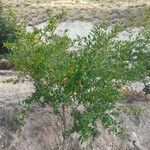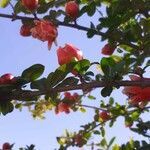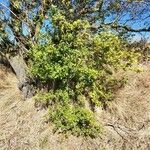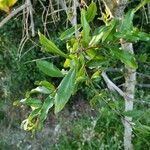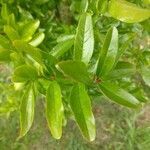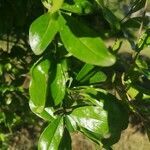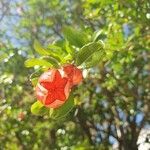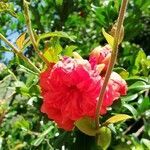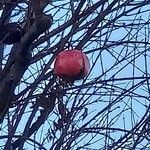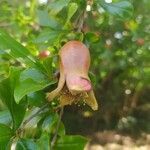Shrubs or small trees, 2-3 m tall, glabrous. Branches and branchlets 4-angled, becoming terete with age, often terminating as indurate spines. Petiole 2-10 mm; leaf blade adaxially shiny, lanceolate, elliptic-oblanceolate, or oblong, 2-9 × 1-2 cm, base attenuate, apex obtuse or mucronate. Floral tube red-orange or pale yellow, campanulate-urceolate, 2-3 × 1-1.5 cm; sepals 5-9, erect, deltate. Petals 5-9, bright red-orange [or white], obovate, 1.5-3 × 1-2 cm, apex rounded or obtuse. Stamens numerous, included to exserted. Ovary 8-13-loculed, in 2 or 3 superposed layers, lower locules with axile placentation, upper ones with apparent parietal placentation. Fruit globose, leathery berries, variable in color, red to yellow-green or red-brown, 5-12 cm in diam., crowned by persistent sepals, irregularly dehiscent. Seeds obpyramidal within juicy sarcotestal layer, ruby-red, pink, or yellowish white. Fl. Mar-Jul. 2n = 16, 18.
Deciduous tree or shrub to 5 (–6) m high, glabrous. Branches often terminating as spines. Leaves opposite or subopposite, shortly petiolate; lamina lanceolate, oblanceolate to elliptic or ±oblong, (2–) 3–7 (–9) cm long, 0.7–2.5 cm wide, attenuate at base, obtuse to acute at apex, turning yellow in autumn before falling; stipules absent. Flowers often in 2s, to 4 cm across. Sepals triangular, 7–8 mm long, persistent. Petals 5–8 (sometimes double flowers occur in cultivars), obovate, 2–2.5 cm long, crimped on margin, orange-red or bright orange. Fruit ±spherical, 4–9 (–12) cm diam., brownish yellow flushed with red and/or pink to orange-red, red or purblish red. Seeds numerous, each surrounded by a juicy reddish translucent pulp.
A native of Iran and NW. India frequently put in Punicaceae (but scarcely differing from Lythraceae in its inferior ovary, the calyx-tube adnate to the ovary which is many-loculed with the locules superposed in two series, the lower with axile, the upper with parietal placentation) is widely grown for its edible fruit.. Large shrub or small tree, the branches sometimes spiny.. Leaves opposite, subopposite or fascicled, oblong to lanceolate or obovate, up to 7.5 cm. long, glabrous.. Flowers orange-red or crimson, showy, ± 2.5 cm. wide.. Calyx urceolate-funnel-shaped.. Fruit 3.5–12.5 cm. in diameter, but usually about the size of an orange.. Seeds numerous, covered with pulp.
A shrub. It grows up to 2-6 m tall. It has short thorns. It can grow up to 10 m tall. Usually trees lose their leaves at one season during the year. The trunk is covered by reddish-brown bark. Trees often sucker near the base. The leaves are opposite, entire and 8 cm x 1.5 cm. Leaves narrow towards the base. It has large scarlet flowers. These are at the ends of branches. 1-3 flowers occur together. The fruit is round, leathery skinned and up to 10 cm across. It is yellow brown in colour. Inside there are angular hard seeds in a juicy yellow pulp. The seeds are 10 mm long. There are many named varieties.
Shrub, up to 2-6 m high; deciduous. Stems sometimes spiny. Leaves opposite or subopposite; blade narrowly oblong-ovate to obovate, 30-70 x 20 mm, margins entire, glabrous. Flowers: 30-40 mm in diameter; many stamens inserted on corolla tube; petals 4-or 5-merous, red; Aug.-Jan. Fruit a ± globose berry, 50-80 mm in diameter, reddish brown, leathery when ripe; each seed surrounded by an edible aril, white to deep red or purple in colour, seeds embedded in a white, spongy, acid or sweet pulp.
Tree or shrub, often spiny. Leaves simple, ± opposite, stipules rudimentary. Flowers regular, bisexual, usually solitary. Hypanthium red. Corolla imbricate or crumpled in bud. Stamens many on hypanthium tube, developing centrifugally, anthers with longitudinal slits. Ovary with placentation superposed in 2 or 3 layers, each placenta with many ovules. Fruit with leathery pericarp and persistent calyx. Seeds in pulpy, enlarged sarcotestas.
